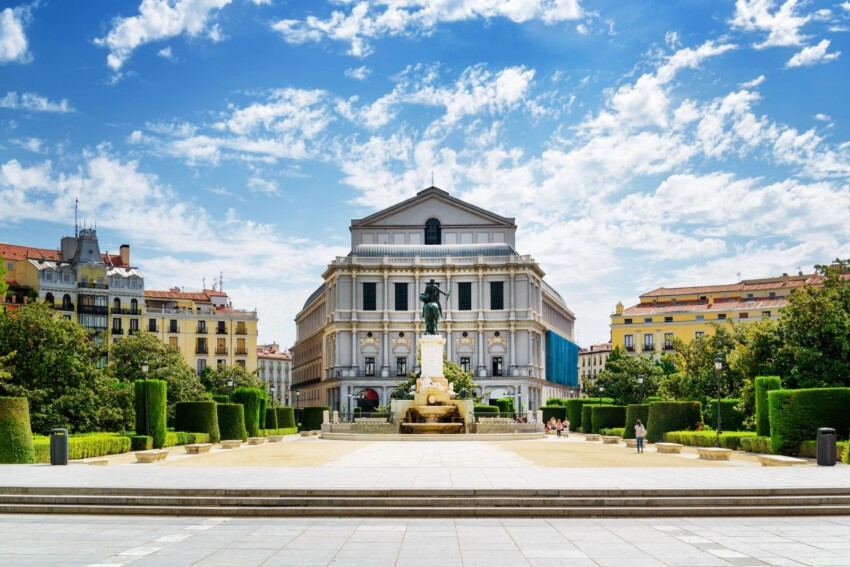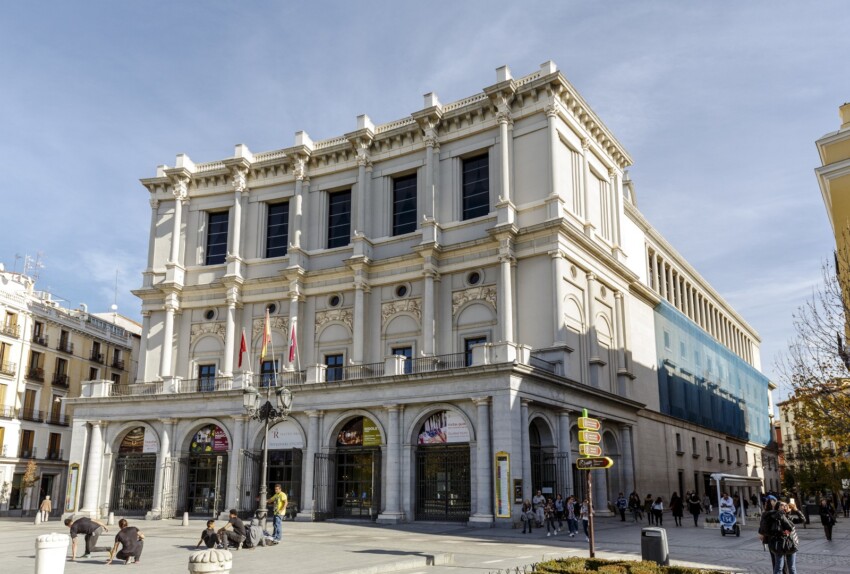

One of the three most important cultural institutions in Madrid, along with the Museo del Prado and the Museo Nacional Reina Sofía, is the Teatro Real, the historic Spanish opera house where the greatest international opera and ballet stars have performed and still perform today.
The two-hundred-year history of this prestigious theatre has not always been glorious and happy: various mishaps jeopardised its existence, but the 1997 renovation brought it back to its former glory, adding modern facilities and functions that have increased the quality of the acoustics and the comfort of the spectators.
The most fascinating way to visit the Teatro Real is to attend a concert or show, choosing from the rich annual programme of classical and contemporary opera. Before you take your seat, take time to admire the theatre’s sumptuous decorations and in particular its magnificent glass chandeliers from the Real Fábrica de la Granja.
However, we also recommend a guided tour of the theatre, day or night: it is the only way to penetrate inside the secrets of the Teatro Real and discover how the magic of an opera is produced every night.

For one day forget being a spectator and experience the magic of the theatre as a protagonist: with a guided tour of the Teatro Real you can enter rooms that are normally closed to the public, such as the rehearsal rooms, dressing rooms or the luxurious royal box, and step onto a stage trodden by international opera stars.
You can choose between different types of guided tours.
The general tours, available every day in the morning, focus on the history of the Teatro Real, its architecture and decorations; you can discover the general workings of an opera house and some interesting facts about the Teatro Real.
After an artistic visit to the Teatro Real , opera will have no more secrets for you! All the artistic aspects of the creation of an opera will be explained to you in detail: how rehearsals take place, how the entrance to the stage is conceived, what are all the professional figures in the costume and stage departments, including the fundamental role of the stage manager. You will also discover secrets and curiosities of current productions.
The technical visits are designed for those who have always wondered how complex stage designs change so quickly and how long it takes to prepare the set for an opera and to remove it. You can see the set-up of a production in progress and the preparation for the next one.
The night tour, available only on specific days of the year, is a unique opportunity to discover what happens in a theatre after the curtain has come down. You can see the areas that made the magic of the opera possible from a technical point of view and the rooms where the artists were before and after the performance.
All visits are available in Spanish and, on request, also in English, French or German.
Getting to the Teatro Real in Madrid is very convenient, as the square it overlooks is the Opera stop of the metro. Lines 2 and 5 stop here, as well as the Ramal line, or line R, a kind of shuttle train that connects Opera station to Principe Pio station.
If you are in the centre of Madrid, the Teatro Real is within easy walking distance, being 8 minutes from Plaza Mayor, 10 minutes from Puetrta del Sol, and 7 minutes from the Callao metro stop along Gran Via.
The Teatro Real as we know it today is the result of renovations and projects over the centuries. Its foundation dates back to 1818: it was King Fernando VII who wanted to provide Madrid with an opera house that would not fear comparison with the theatres already present in other important European capitals.
During its construction, the architects Antonio López Aguado, Custodio Teodoro Moreno and Francisco Cabezuelo headed the work. The theatre opened its doors to the public in 1850; the inaugural opera was ‘La Favorita’ by the Italian Gaetano Donizetti.
For over 70 years it was one of the most prestigious theatres in Europe, but in 1925 a collapse severely damaged the theatre, causing its closure, which was only supposed to be temporary. The outbreak of civil war caused further damage to the theatre, which was then used as a warehouse for firearms.
It was not until 1966 that the theatre was reopened, but only as a concert hall. Major renovations were carried out between 1991 and 1997, with the addition of a conference room, an exhibition space, new dressing rooms, rehearsal rooms and storage rooms.
The theatre as we see it today was reopened to the public on 11 October 1997 with the performance of two works by Manuel de Falla, the ballet ‘Sombrero de tres picos’ and the opera ‘La vida breve’.
Here are some interesting facts about Spain’s most prestigious theatre:
The Teatro Real is located in Plaza de Oriente in the Austrias area, the historical and tourist heart of Madrid. It can be easily reached by metro (L1, L2, L3, L5, R) or on foot from the main tourist attractions in the centre.
City Card allow you to save on public transport and / or on the entrances to the main tourist attractions.
